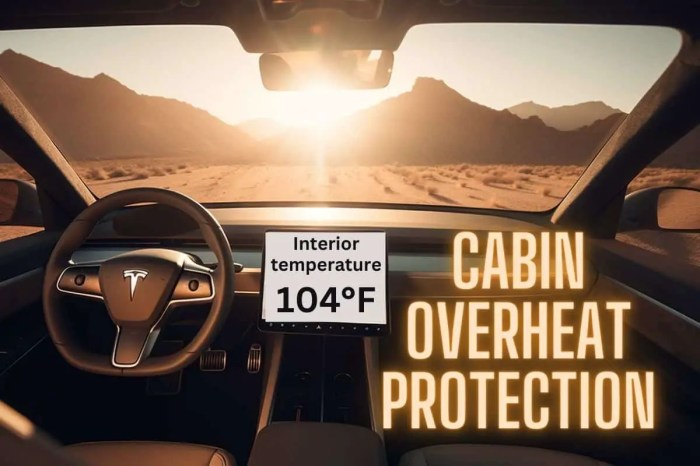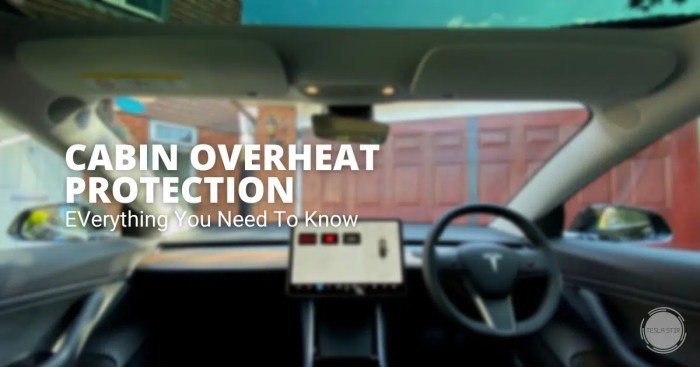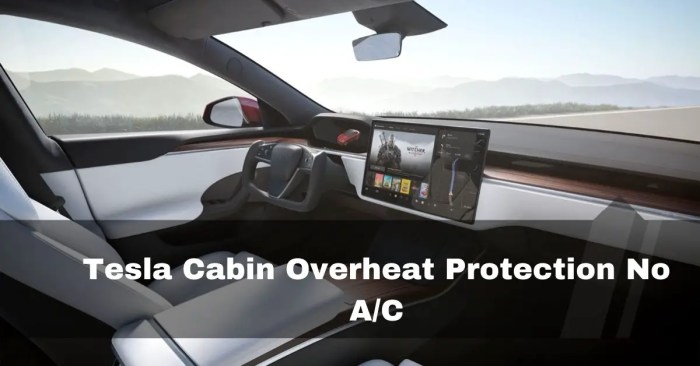Cabin overheat protection no a/c – Cabin overheat protection without A/C poses unique challenges, but with the right strategies, it’s possible to maintain a comfortable indoor environment even in extreme temperatures. This article explores passive and active cooling techniques, design considerations, and energy-efficient solutions to mitigate cabin overheating.
Cabin Overheating Causes

Cabin overheating without air conditioning can occur due to several factors. Understanding these causes is crucial for developing effective strategies to mitigate cabin temperature rise.
Insulationplays a significant role in cabin temperature regulation. Insufficient insulation allows heat from external sources, such as sunlight and ambient air, to penetrate the cabin. This heat buildup can lead to uncomfortable and potentially hazardous conditions inside the cabin.
Ventilationis another critical factor affecting cabin temperature. Proper ventilation allows for the exchange of air between the cabin and the outside environment. When ventilation is inadequate, warm air becomes trapped inside the cabin, leading to overheating. Factors such as closed windows, blocked vents, or insufficient air circulation can contribute to poor ventilation.
Sunlightis a major source of heat gain in cabins. Large windows and skylights allow sunlight to enter the cabin, which can significantly increase the temperature. Direct sunlight on the cabin’s exterior can also heat the cabin’s structure, transferring heat into the interior.
Common Overheating Scenarios
- Parked cars:Closed vehicles parked in direct sunlight with closed windows can experience rapid temperature rise due to the greenhouse effect.
- Cabins in hot climates:Cabins located in regions with high ambient temperatures and limited ventilation are prone to overheating, especially during peak summer months.
- Overcrowding:Excessive occupancy in a cabin can increase body heat output, contributing to cabin temperature rise.
- Cooking and heating appliances:Using cooking or heating appliances inside a cabin can release significant heat, leading to overheating if ventilation is inadequate.
Passive Cooling Techniques

Passive cooling techniques offer a sustainable and cost-effective way to maintain a comfortable indoor environment without the need for air conditioning. These techniques rely on natural principles and architectural design to dissipate heat and create a cooler living space.
Natural Ventilation
Natural ventilation involves using openings in the building envelope, such as windows, doors, and vents, to create airflow. By allowing cooler air to enter and warmer air to escape, natural ventilation can effectively reduce indoor temperatures.
- Position windows and doors on opposite sides of the cabin to facilitate cross-ventilation.
- Install vents near the ceiling and floor to allow warm air to escape and cool air to enter.
- Use fans or wind catchers to enhance airflow.
Cross-Ventilation
Cross-ventilation is a type of natural ventilation that involves creating a flow of air through the cabin by opening windows or doors on opposite sides. This allows fresh air to enter and stale air to escape, reducing indoor temperatures and improving air quality.
- Open windows or doors on opposite sides of the cabin, even if they are not directly facing each other.
- Use fans or wind catchers to increase airflow.
- Avoid blocking airflow with furniture or curtains.
Thermal Mass, Cabin overheat protection no a/c
Thermal mass refers to materials that have a high heat capacity, such as concrete, stone, and brick. These materials absorb heat during the day and release it slowly at night, helping to regulate indoor temperatures.
- Incorporate thermal mass materials into the cabin’s construction, such as concrete floors or stone walls.
- Expose thermal mass materials to sunlight during the day to absorb heat.
- Cover thermal mass materials with insulation at night to prevent heat loss.
Active Cooling Options
In situations where traditional A/C systems are not feasible, alternative cooling options offer viable solutions to mitigate cabin overheating. These active cooling methods do not rely on refrigerants and provide efficient temperature regulation.
The choice of active cooling option depends on factors such as cabin size, climate conditions, and available resources. Each method has its own advantages and disadvantages, and selecting the most suitable option requires careful consideration.
Evaporative Coolers
Evaporative coolers, also known as swamp coolers, operate on the principle of evaporative cooling. They draw in hot, dry air and pass it through a water-saturated pad. As the water evaporates, it absorbs heat from the air, resulting in a cooler and more humid environment.
Evaporative coolers are most effective in dry climates with low humidity levels.
- Pros:Low energy consumption, low maintenance costs, and effective cooling in dry climates.
- Cons:Ineffective in humid climates, may increase indoor humidity levels, and require a water source.
Fans
Fans provide localized cooling by circulating air and creating a wind-chill effect. They do not lower the air temperature but can make occupants feel cooler by increasing air movement and promoting evaporation from the skin.
- Pros:Low energy consumption, low cost, and easy to install.
- Cons:Do not reduce air temperature, may not be effective in high-temperature environments, and can be noisy.
Radiant Cooling Systems
Radiant cooling systems utilize the principle of radiative heat transfer to cool a space. They emit cool temperatures from surfaces, such as ceilings or walls, which absorb heat from the occupants and surrounding air. Radiant cooling systems are energy-efficient and provide a comfortable cooling experience.
- Pros:Energy-efficient, comfortable cooling, and low noise levels.
- Cons:High installation costs, complex design and installation, and may not be suitable for all cabin sizes.
Design Considerations for Overheat Protection: Cabin Overheat Protection No A/c
Cabin design plays a crucial role in mitigating overheating. Proper insulation, strategic window placement, and optimized roof overhangs can significantly reduce heat gain and improve thermal comfort.
Insulation
Adequate insulation is essential for preventing heat transfer through the cabin’s walls, roof, and floor. High-quality insulation materials, such as cellulose, fiberglass, or spray foam, create a barrier that slows down the flow of heat. This helps maintain a stable indoor temperature by preventing excessive heat gain during hot weather.
Window Placement
Windows allow natural light and ventilation into the cabin, but they can also contribute to overheating if not properly placed. Windows should be strategically located to maximize natural cross-ventilation and minimize direct sunlight exposure. Placing windows on opposite walls allows air to flow through the cabin, creating a cooling breeze.
Additionally, installing awnings or blinds over windows can block out direct sunlight and reduce heat gain.
Roof Overhangs
Roof overhangs extend beyond the perimeter of the cabin’s walls, creating shaded areas that reduce heat gain. Overhangs can be particularly effective in blocking the sun’s rays during the hottest part of the day. By extending the overhangs, the amount of sunlight hitting the cabin’s roof and walls is reduced, leading to a cooler indoor environment.
Airflow Optimization
Optimizing airflow is crucial for removing excess heat from the cabin. Installing ceiling fans or vents can circulate air and create a cooling breeze. Openings on opposite sides of the cabin allow air to flow through and carry away heat.
Additionally, using light-colored roofing materials and planting trees around the cabin can help reduce heat absorption and promote natural cooling.
Energy-Efficient Solutions

Energy-efficient solutions offer a sustainable and cost-effective approach to mitigating cabin overheating. By implementing strategies that reduce energy consumption, we can minimize heat generation and create a more comfortable indoor environment.
The use of energy-efficient appliances, lighting, and building materials plays a crucial role in reducing energy consumption. Energy-efficient appliances, such as refrigerators, air conditioners, and water heaters, consume less energy to operate, resulting in lower heat emissions. Similarly, energy-efficient lighting, including LED and CFL bulbs, produces less heat compared to traditional incandescent bulbs.
Building Materials
The selection of building materials also influences cabin overheating. Materials with high thermal mass, such as concrete and stone, can absorb and store heat, releasing it slowly over time. This helps to regulate indoor temperatures, reducing the need for active cooling systems.
Renewable Energy Sources
Integrating renewable energy sources, such as solar panels, into cabin design can further reduce energy consumption. Solar panels generate electricity from sunlight, which can be used to power appliances, lighting, and other electrical systems. By reducing reliance on grid electricity, we can minimize heat generation and create a more sustainable energy solution.
User Queries
What are the common causes of cabin overheating?
Insufficient insulation, poor ventilation, direct sunlight, and lack of thermal mass can all contribute to cabin overheating.
How can natural ventilation be used to cool a cabin?
Opening windows and doors on opposite sides of the cabin creates a cross-breeze that helps circulate air and remove heat.
What are the benefits of using energy-efficient appliances and lighting in a cabin?
Energy-efficient appliances and lighting consume less electricity, reducing the heat generated within the cabin and lowering energy bills.